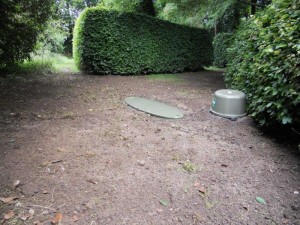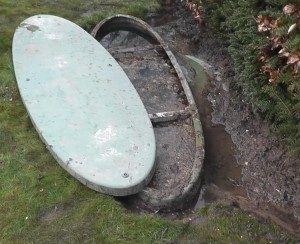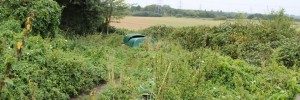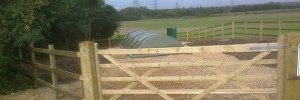Case Studies
Case study….Prospect House, Lymington
Although we most commonly install foul water drainage, we are, as our name suggests, experts in all manner of drainage solutions.
We have just received a commission for a bespoke system to supply a potable water system to a 5 bedroomed property together with water for outdoor irrigation.
The property currently receives all its domestic water via a well in the cellar of the house. Unfortunately this being England where we are not known for periods of prolonged good weather, the well has a tendency to overflow, flooding the cellar on a regular basis.
The house is about to undergo renovation work, so the homeowners decided that this would be a good time to tackle the flooding problem. This is where we came in.
An MDPE tank for potable water was to be installed in the grounds – the usual GRP tank not being suitable due to the risk of styrene poisoning. Inside the tank, two ‘Divertron’ pumps with pressure sensors are fitted, which pump water independently to the house and garden. On reaching the house the water goes through a series of micron filters and UV sterilisation to eradicate any bacteria or viruses. This is not necessary for the water to the irrigation system.
The storage capacity required and therefore the size of tank necessary, was calculated taking into account the flow rate of the well, against the usage of the house and irrigation system. The tank is continually refreshed from the well, the refresh rate of which was calculated using summer figures. The tank, therefore, does not need to hold a full day’s supply.
Finally the well was capped off, and a reinforced glass viewing window was fitted into the floor of the now dry cellar.
Should the well run dry, or the electricity supply be lost for a long period, the homeowners have the ability to bypass the tank and switch to a conventional gravity fed system. Either system can run independently of the other, but the two should never be allowed to meet!
Case study….Hothorpe Hall, Leicester
Hothorpe Hall is a beautiful stately home in Lutterworth, Leicestershire being run as a luxury hotel and conference centre. A new rustic wedding function suite is currently under construction in the grounds, with EDS having been commissioned to install the drainage.
A very large sewage treatment plant together with a crude pump station and drainage was required, to cater for the expected guest population of 200 at a time.
All was ordered and ready to go, when at the last minute we were told that the drainage could not be installed as planned. An arborologist had intervened putting a stop to the works, as the excavations would be too close to some very old trees and shrubs. Had the drainage been installed with heavy digging machinery as planned, this could have meant that there was a risk that their roots and water supply would be jeopardised. The drainage, therefore had to be dug out by hand.
The installation of the sewage treatment plant itself also hit upon a snag – albeit a very interesting one! Excavation of the huge pit required to accommodate the treatment plant was started in earnest, and all was going well until one of the team noticed some large stones neatly in a row in the crater, resembling a row of giant’s teeth. As this area was the Viking centre of the ancient kingdom of Mercia, it contains many ancient burial chambers from the period – an archaeologist was therefore called in to give an opinion. After painstakingly brushing, photographing and logging the stones, it was decided that these would most probably have formed part of an ancient boundary wall. That having been said, and the stones recorded for posterity, excavations recommenced and the 9th Century stones were once again covered over, consigned back to the depths to be re-discovered in maybe the 22nd Century?
Hothorpe Hall itself makes a piece of modern-day history, being as it was the birth place of Lt Col Simon Elwes, a renowned British war artist and portrait painter of the rich and famous. Many kings, queens, presidents and statesmen had their portraits painted by this gentleman, together with one Countess of Carnarvon. Anyone who has read the book of Downton Abbey will be familiar with this portrait of the Countess, as it is this that graces the front cover of the book.
Case Study – Klargester BioTec P1 Installation in the Pewsey area
We were initially approached by our customer to install a small packaged treatment plant to serve a building that was in the process of being converted to a 3-bedroom living accommodation.
The building was formerly an indoor swimming pool and foul drainage was originally served by a sealed cesspool.
A trial hole was excavated to establish the subsoil conditions and percolation tests were carried out. From the percolation test results we were able to calculate the area of the drainage field required in accordance with the British Standard Code of Practice BS 6297:2007 for the design and installation of drainage fields for use in wastewater treatment.
The percolation test results dictated the requirement for 45m2 of drainage field and the only location suitable for this was a lawn area situated uphill of the proposed treatment plant.
Therefore, the BioTec was supplied with an integral pump to lift the treated effluent to the head of the drainage field. The BioTec was selected for this particular project as there are no mechanical or electrical components within the plant itself. The plant also has low running and maintenance costs.
Despite having limited access for delivery of materials and muckaway the project was finished on time and within budget.
The attached photos are the before and after shots. The area has been levelled and laid with grass seed.
CASE STUDY SITE – WINCHESTER
During the winter storms of January 2014 large areas of the country received excess rain fall which resulted in flash flooding, prolonged flooding and rising of water tables. This put extreme pressure on off mains drainage. Many tanks failed to work effectively and others simply collapsed or popped out of the ground. Over the last several months we have been reinstalling, repairing and flood proofing many systems (some of which has been processed through insurance claims).
Such as the site pictured below in the Winchester area. The local ground water rose and flooded into the soakaway and then over the lid of the sewage treatment plant. This left three detached properties in a small development without drainage for a prolonged period of time.
In order to protect the site from ground water flooding a new plant was installed with an internal pumpstation and non return valve to stop water coming back into the plant. The plant also had a higher skirt to raise the top clear of the ground water springs that were running into the sewage treatment plant. The treated effluent was then pumped to an improved soakaway. The new solution provides an on going secure, effective flood proof system.
CASE STUDY SITE – HAYES HILL FARM, ESSEX
Hayes Hill Farm consists of a visitor attraction farm, incorporating toilets and a restaurant together with two, four bedroom cottages.
The work included the design, supply, installation and commissioning of an entire sewage treatment plant system together with the removal of the existing failed treatment plant.
The contract was won by Environmental Drain Services Ltd following a tender process and a new system was installed comprising of a 45000 litre primary settlement tank, a rotating biological contactor, a final settlement tank and a sludge return chamber.
The site had to remain operational throughout the installation works and the new system had to be capable of handling the full range of anticipated flow rates.
The project was completed within the allocated time and budget and is now operational and successfully achieving the water quality required to satisfy The Environment Agency permit to discharge.










